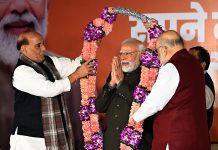 Hindu mythology is known for its fascinating narratives spun around a multitude of philosophical thoughts. While the stories mostly follow an inconsistent thread, what binds them is the core encompassing the trinity — Brahma, Vishnu and Mahesh. Interestingly, each account of the trinity offers only a rough sketch of the characters and the elements that define their identity. In her book, The Man From The Egg: Unusual Tales About The Trinity, author Sudha Murty, dives directly into these microscopic characteristics that elevate the trinity from mere mortal beings. But do Gods cheat, too? Do they make mistakes and do they fight for power? This book surely answers these right from the first page.
Hindu mythology is known for its fascinating narratives spun around a multitude of philosophical thoughts. While the stories mostly follow an inconsistent thread, what binds them is the core encompassing the trinity — Brahma, Vishnu and Mahesh. Interestingly, each account of the trinity offers only a rough sketch of the characters and the elements that define their identity. In her book, The Man From The Egg: Unusual Tales About The Trinity, author Sudha Murty, dives directly into these microscopic characteristics that elevate the trinity from mere mortal beings. But do Gods cheat, too? Do they make mistakes and do they fight for power? This book surely answers these right from the first page.
The Man from the Egg is a light hearted children’s book, both in context and weight. It is a simple collection of short stories derived from mythological incidents revolving around characters and customs from Hindu folklore like Rakshashas, Asuras, Brahmins, Kings and a lot of tapasyas. It would be fair to say that the award-winning author finds most of her inspirations from childhood stories and, hence, makes it a book focused on re-telling epics than one fetched from original ideas. However, while The Man from the Egg does not vouch for factual authenticity, what it does present is a
refreshing take on the age-old stories. What the book essentially does is to effortlessly answer some of the most common questions that continue to intrigue us. So, if you are among the ones who still wonder why Shiva has a snake wrapped around his neck or are unable to figure why Brahma has four heads, grabbing a copy of this book would be the right choice.
What is interesting about the book is that it draws relevance to the stories by presenting present locations where the particular incidents might have taken place. For example, Shiva dropped the fifth head of Brahma in Varanasi (thus founding the city) after smoting it off in a fight. Also, Kashi became famous as the place where Ganga came pouring out of Shiva’s head during the battle of Gajasura.
Indeed, The Man From the Egg has many gems for readers who are interested in understanding the stories behind many places as well as customs. One of the chapters on Vishnu narrates the story of how the tulsi plant came to be worshiped among Hindus. Another explains why Shiva is worshiped as Ardhanarishvara, a half man and half woman form, carvings of which can still be found in the Badami caves in Karnataka.
 While the whole of Murty’s book revolves around the trinity, its chapters are divided into three parts — Omkara Swarupa, Satyam Shivam Sundaram and Sambhamami Yuge Yuge each focusing on Brahma, Shiva and Vishnu, respectively. While almost all the stories have an independent context, it is advisable to read them in order to get a better understanding of the flow and the past characters. The Man from the Egg makes for an interesting read because of its clear and comprehensible language. In fact, it is a good attempt at compressing the tedious mythological tales into crisp stories, especially helpful for those who read on the go. What is interesting is that while the author maintains the crux of the divine characters, she tries to add the human aspect to their actions. So, while the Gods might not necessarily cheat, they do have the habit of manipulating their blessings, especially for their Asura devotees. After all they have the bigger task of maintaining the right balance on Earth, Heaven and even Hell. How do they do that? Murty’s tales about the trinity should help reveal the tricks up their sleeves.
While the whole of Murty’s book revolves around the trinity, its chapters are divided into three parts — Omkara Swarupa, Satyam Shivam Sundaram and Sambhamami Yuge Yuge each focusing on Brahma, Shiva and Vishnu, respectively. While almost all the stories have an independent context, it is advisable to read them in order to get a better understanding of the flow and the past characters. The Man from the Egg makes for an interesting read because of its clear and comprehensible language. In fact, it is a good attempt at compressing the tedious mythological tales into crisp stories, especially helpful for those who read on the go. What is interesting is that while the author maintains the crux of the divine characters, she tries to add the human aspect to their actions. So, while the Gods might not necessarily cheat, they do have the habit of manipulating their blessings, especially for their Asura devotees. After all they have the bigger task of maintaining the right balance on Earth, Heaven and even Hell. How do they do that? Murty’s tales about the trinity should help reveal the tricks up their sleeves.
letters@tehelka.com











